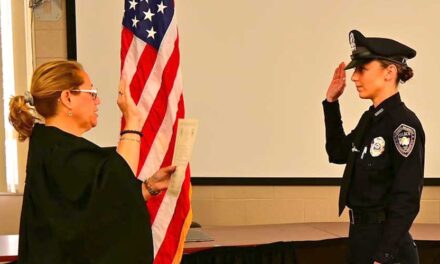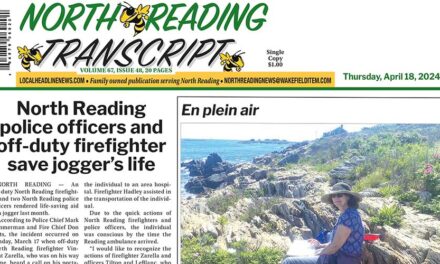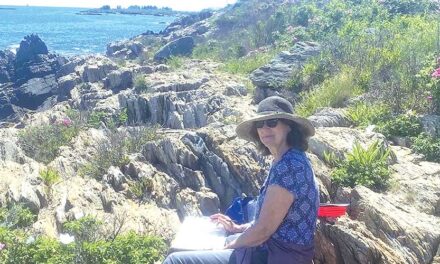Published in the July 30, 2015 edition
By MAUREEN DOHERTY
NORTH READING — Drainage issues rank among the most pressing concern of town officials and abutters to the seven-lot subdivision at 17 Anthony Rd. proposed by Joseph Germano and JCJ Realty Trust of Tewksbury.
The proponents will return to the Community Planning Commission (CPC) next Tuesday, Aug. 4 at 8 p.m. to continue discussions on the definitive plan. Engineer Kenneth Lania was directed to submit revisions to the plan to address matters raised by the town planner, town engineer, health agent, utilities superintendent and fire department.
Access to the narrow strip of land that runs just under 1,000 feet between the rear properties along Anthony Road as well as properties on Mohawk Road in Andover and behind land at 346 Haverhill St., would be gained by removing the home at 17 Anthony Road.
A proposal made by Germano last fall seeking permission from the Zoning Board of Appeals (ZBA) to reposition this house on the lot and offer it to the town as an affordable home through the Local Initiative Program was withdrawn without prejudice due to significant neighborhood opposition. This idea was first proposed back in 2011 during submittal of preliminary subdivision plans with the CPC. But the definitive plan filed by Germano on June 30 eliminates the home.
In her review of the plan, Town Planner Danielle McKnight stated in a memo to the board that while the plan shows seven house lots only six homes are depicted on the plans. The lots meet the area requirement but lots 2 and 3 appear to be positioned in a way that may make it difficult to meet the minimum rear yard setback, which will require confirmation by the building inspector. She was away on vacation during this meeting.
The entire site is within the town’s Aquifer Protection District (APD), McKnight stated and this should be delineated on the plan. “Based on the size of the project and the apparent drainage challenges,” McKnight said the town engineer is recommending a peer review of the proposal by the town’s consulting engineering firm, DCI, at the applicant’s expense.
Further complicating development of the property is the presence of a 200-foot wide electrical easement owned by National Grid on the westerly side of the site.
McKnight advised the CPC in her memo that she forwarded the plans to National Grid with a request to expedite their review due to the 90-day timeframe the town could be subjected to from the date of submission to avoid a constructive approval of the plan in late September. However, she pointed out that the board’s approval may need to be subject to the applicant obtaining the necessary approvals from National Grid to work in the area.
Lania told the board that he had contacted Steven Towle to get this process underway but did not expect a decision within 90 days.
CPC Chairman Chris Hayden told Lania that he was not “too happy” that Lania had not initiated this review with National Grid sooner since getting that approval was discussed by the applicants during the preliminary plan approval process.
“You are working in their easement area without approval. Even if we gave you a decision it is all going to be based on them,” Hayden said. Lania said they are allowed to span the easement perpendicular. A septic system for one lot and a retaining wall would be affected by the easement, he said.
The maximum height of this retaining wall is 12 feet and it would be a Shea concrete wall. Hayden told him to “step it back” because “the neighbors won’t want to see it,” a reference to the controversy concerning a large retaining wall erected for a lot on Bishops Lane a few years back that met with quite a bit of opposition from the neighborhood.
The Germanos have been trying to develop the land behind Anthony Road for nearly 30 years and many of the two dozen neighbors who attended the July 21 public hearing have lived in the neighborhood for decades and have seen many proposals made, but none come to fruition.
Complications concerning the neighborhood’s historic flooding issues were illustrated by a review of the plan by Health Agent Martin Fair who stated in a July 21 memo to the board that while the land is generally “suitable for on-site sewage disposal and residential development” he has several concerns over this proposal.
Namely, Fair stated: “Due to groundwater levels in the area there could be six feet of standing water in drainage reservoir No. 1 and five feet of standing water in drainage reservoir No. 2 during the winter and spring months.” Fair pointed out that no calculations or methodology were included to support the proposed drainage design, but explained, “If the reservoirs are already full to these elevations with water, storage at or below these elevations would be unavailable during a storm.”
Fair added in the spring, reservoirs filled to this level would require “mosquito larval control application.”
Fair was also concerned with the 12-foot height of the retaining wall at the right of way on Lot 1 and added that the plan he was given for review was not stamped by a registered professional engineer and no filing was made by the applicant with the Board of Health. “I assume this is not an official submission of a definitive subdivision plan but more of an unofficial filing for discussion about a definitive plan that will be filed,” he stated.
Both Fair and Utilities Superintendent Mark Clark pointed out that the proposed water loop as shown would provide no benefit in increasing water circulation since there was no change in elevation and it merely created excess infrastructure for the town to maintain in the future.
Town Engineer Mike Soraghan advised the CPC in his July 16 memo that “in general, the plans need to be checked more thoroughly for obvious errors and resubmitted.” Soraghan added that the site is subject to the town’s stormwater bylaw and management rules and regulations but no stormwater report has been submitted by the engineer for his review and comment. “This review is required,” he stated.




